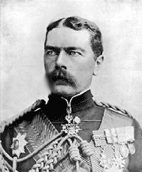To a standing room only audience, Dr. Stephen Heathorn kicked off the Fall Thursday Seminar series in the Department of History with a talk entitled ‘Long Before Oliver Stone…Conspiracy Theory and the ’Kitchener Films’ 1921-26.’  Heathorn’s talk centred on the backstory to a half-decade struggle to bring the movie ‘How Kitchener Was Betrayed’ to British screens during the early 20s. He used this episode to demonstrate how official policy perpetuated the Kitchener myth and avoided questions of professional competence. This paper comes from a larger exploration of how memory and reputation of martial leaders is manipulated over the space of the 20thC.
Heathorn’s talk centred on the backstory to a half-decade struggle to bring the movie ‘How Kitchener Was Betrayed’ to British screens during the early 20s. He used this episode to demonstrate how official policy perpetuated the Kitchener myth and avoided questions of professional competence. This paper comes from a larger exploration of how memory and reputation of martial leaders is manipulated over the space of the 20thC.
In 1916, Kitchener drowned on a mission to Russia when the ship he was aboard struck a mine off the Orkneys. Public grief was intense over the loss of the man who symbolized the fighting spirit of the nation and led many to question the culpability of military and politicians in the tragedy. Although the mines that lay in the path of the Hampshire were known to some in the admiralty, in the fog of the aftermath of Jutland, this intelligence probably failed to reach Scapa Flow in time to divert the mission. The failure of the government to publicly reveal the results of the investigation into the sinking gave birth to several conspiracy theories. In 1921, this led to the film ‘How Kitchener Was Betrayed,’ which spun a tale involving a traitorous british officer, a beautiful german spy and Rasputin. The film was immediately banned by official bodies seeking to maintain Kitchener’s iconic status as symbolic of ultimate sacrifice for the nation. When the film could not be shown, the original owners sold it to Frank Powers, a journalist of some repute. He re-edited the film now calling it ‘the Tragedy of the Hampshire’ and once again attempted to gain official acceptance. Despite removal of the plot involving the German spy and the British officer, a license for the film could not be obtained. In a last desperate attempt to get some return on his investment in the film, Powers claimed to have discovered the body of Kitchener in Norway in 1926. Staging an elaborate tour of Norway with a casket in tow, he returned via Scotland to London. When pathologists pried open polished casket they discovered only a thick layer of tar inside.
Using papers declassified in 2001, Heathorn demonstrates that there was a concerted effort on the part of authorities to prevent the showing of this film (considered most persuasive media of the time) in a manner which might raise questions of professional competence on the part of the government and the military. He asserts that ironically, it was this lack of transparency and unwillingness to publicly challenge Powers that fed the sense of conspiracy. Officials saw the dramatic portrayal of Kitchener’s demise as a clear challenge to the legitimacy of the state. Despite a difficult wartime relationship, both the Home and War offices agreed that Kitchener’s reputation could not be tarnished. He was the symbol of all that made the fighting just and worth the cost.

Hi Shawn,
I am interested in the Lord Kitchener equestrian statue, by Sydney March, which was erected in Calcutta, then moved in 1921 to Khartoum, and then moved again in 1958 to Chatham in Kent. My question is why was it moved from Calcutta? Is there any connection to the Curzon-Kitchener disagreements?
Sincerely,
Richard Barnes
Dear Richard,
Thanks for being in touch. Dr Stephen Heathorn, the speaker referred to in this article would be a better contact on this than myself. He can be contacted at: heaths@mcmaster.ca.